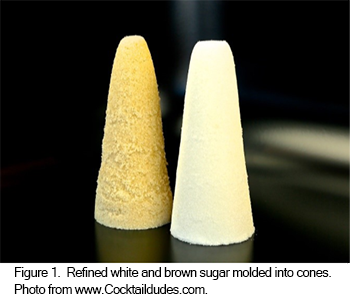Curator's Choice 2020
Sugar Nippers
August 2020
By Patricia Samford, MAC Lab Director
 Until the late 19th century, refined sugar was sold in loaf form – cylindrical cones that were molded into different sizes (some as tall as three feet!), wrapped in paper and sold to the individual consumer (Figure 1). Breaking the hard sugar into smaller chunks to be processed for cooking or sweetening beverages required a tool that would have been instantly recognizable to our colonial ancestors. Sugar nippers (also called nips, cutters or tongs) had curiously-shaped blades and were designed to be used like scissors to separate smaller chunks of sugar from the cone. Miss Leslie's Lady's House-Book, published in 1850,
Until the late 19th century, refined sugar was sold in loaf form – cylindrical cones that were molded into different sizes (some as tall as three feet!), wrapped in paper and sold to the individual consumer (Figure 1). Breaking the hard sugar into smaller chunks to be processed for cooking or sweetening beverages required a tool that would have been instantly recognizable to our colonial ancestors. Sugar nippers (also called nips, cutters or tongs) had curiously-shaped blades and were designed to be used like scissors to separate smaller chunks of sugar from the cone. Miss Leslie's Lady's House-Book, published in 1850,

advised readers that “a pair of sugar-nippers are indispensable, for breaking small the loaf-sugar after it has been cracked with a stout knife and a mallet or hammer.” (Leslie 1850:235).
A pair of iron sugar nippers were discovered during archaeological excavations at Oxon Hill/Addison Plantation (18PR175) in Prince George’s County, Maryland (Figure 2). They were found on the ground surface near the former Addison manor house, built in 1710 and destroyed by fire in 1895 (McCarthy et al . 1990).
The Addison family’s sugar nippers were of the handheld variety. A small leg or spike that projected from one of the handles at a right angle was held against the tabletop to steady the nippers and provide more control (Figure 3). The Addison sugar
nippers were missing this spike, and one of the blades was broken as well. Tabletop nippers were mounted horizontally on boards, allowing the user greater force with the blades (Old and Interesting 2009).
Sugar nippers for use in the kitchen were generally made of iron—like the Addison example—or of silver for use with tea services. Some iron examples were decorated at the joint between the two handles (Jamestown Yorktown Foundation 2015), but the Addison example was undecorated.
Granulated and cubed sugar, introduced in the late 19th century, were the death knell for sugar nippers. Since that time they have been relegated to the odd kitchen curiosity that shows up in antique shops.
References |
| |
| Jamestown Yorktown Foundation |
2015
|
Sugar Nippers: An Essential Component of Well-Equipped 18th-Century Kitchens. Website accessed March 13, 2020 at https://www.historyisfun.org/blog/sugar-nippers/. |
|
Leslie, Eliza
|
| 1850 |
Miss Leslie's Lady's House-book: A Manual of Domestic Economy. A. Hart, Philadelphia.
|
| |
McCarthy, John P. and Jeanne A. Ward, George D. Cress and Charles D. Cheek
|
1990
|
Intensive Archeological Survey of the Addison Plantation Site and Intensive Archeological Testing of the Addison Manor Foundations, Beltway Parcel, PortAmerica Development, Oxon Hill, Prince George’s County, Maryland. John Milner and Associates, West Chester, PA. Website accessed March 17, 2020 at http://colonialencounters.org/files/sitereports/Addison-3.pdf.
|
| Old and Interesting |
| 2009 |
Sugar Cutters & Nippers. Old & Interesting; History of Domestic Paraphernalia. Website accessed March 13, 2020 at http://www.oldandinteresting.com/sugar-nippers.aspx. |
| |
|
| |
| |